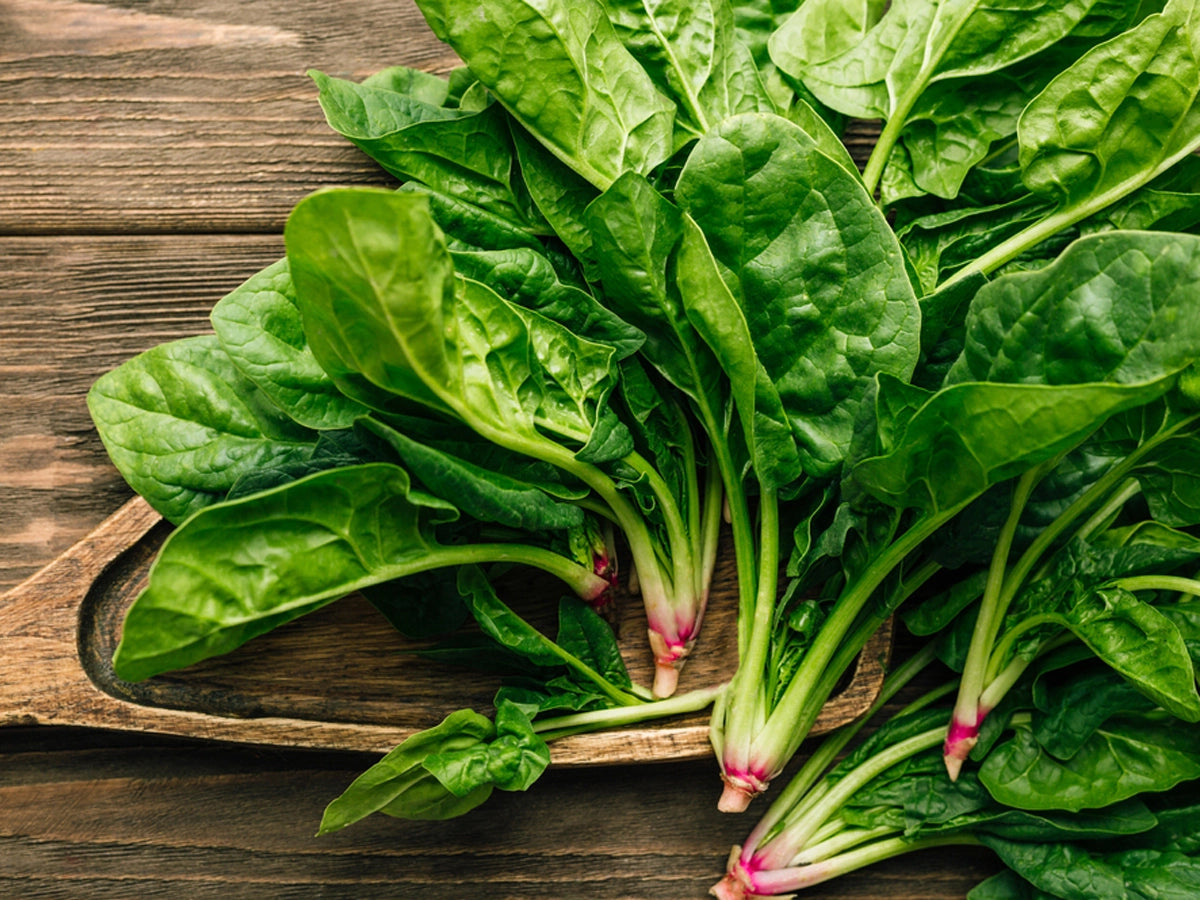How to Grow
Spinach (Paalak): Mastering the Art of Growing and Caring for the Winter Kitchen's Gem
Colorful flowers, vibrant vegetables, and leafy vegetables around you mean that winter has arrived.
Spinach is the most well-liked of all the leafy vegetables that winter provides for your kitchen. In many households, there is a tradition of mixing spinach with methi or bathua.
You might be wondering why spinach deserves to be called "the queen of winter kitchen."
That’s because your mom makes sure you get all the essential nutrients and vitamins from spinach. She makes exquisite dishes with spinach, including palak curry, palak paneer, palak cutlet, palak parantha, palak daal, palak pakora, and palak sandwich, among others.
From glowing skin to boosting immunity, from being a natural anti-aging agent to having anti-inflammatory properties – spinach truly deserves all our adoration.
The best part is that you can easily grow spinach at home. We will explain how to grow spinach at home in this blog, along with many other things. Here is what we will discuss: -
- Various interesting facts about spinach
- How to grow spinach at home
- How to take care of spinach
- Major health benefits of spinach
So, let’s start this interesting blog. You will surely know many unknown tips and tricks to maintain a healthy spinach plant.
Various interesting facts about spinach
- Spinach or Spinacia oleracea is a famous leafy green flowering plant native to central and western Asia
- The origin of spinach is supposed to have been in ancient Persia about 2000 years ago. From there it was transported to India and ancient China in 647 AD under the name "Persian vegetable."
- China produced 92% of the total production of spinach in the world in 2020.
- Do you know that the popularity of spinach rose with the cartoon character Popeye – the sailor man? In the 1930s, the farmers credited the boost in the production and sale of spinach to this cartoon. There was a 33% spike in the consumption of spinach, which was much needed during the Great Depression.
- The green color of spinach is a result of the thylakoids found within its cells. They help keep one full for a long time and aid in weight loss.
- Did you know that 91% of spinach is water?
- Spinach is related to beets.
- Savoy spinach, flat-leaf spinach, and semi-savoy spinach are the only three types of spinach.
How to grow spinach at home
Growing spinach at home is easy. Follow our instructions mentioned below and enjoy palak recipes: -
Choose the variety
Pick a savoy or semi-savoy type of spinach. They have dark green leaves that are crisp. If you want quicker growth, choose the smooth-leaved spinach variety. Smooth-leaved spinach is the ideal complement to any summer salad and grows fast and effortlessly.
Time to grow
Spinach can be grown all around the year but fall would be the best time to sow them. Plant them in September or October to enjoy spinach all through the winter season.
Prepare soil for spinach
- Spinach prefers a somewhat damp habitat, but it will not thrive in soil that frequently floods or has poor drainage. So, choose a well-draining soil of any type and then raise its fertility by adding compost or fertilizer.
- Check the soil pH which should be between 6.5 and 7.0.
- Add manure, alfalfa meal, soybean meal, cottonseed meal, blood meal, or any other high-nitrogen fertilizer to the soil.
Get spinach seeds
Get spinach seeds from a local store and then soak them in water for 24 hours.
Seed preparation
A week before planting them in the soil, you must soak the seeds in water for a day. Then keep these seeds in an airtight container at a cool temperature.
Planting
Now, take a medium-sized pot and fill it with 75% of the soil mix. Scatter the seeds two inches apart from each other, and then cover them with soil for half an inch.
Mulch
To stop weeds from growing, mulch the soil of the planting area with a few inches of hay, straw, leaves, or grass. Mulch is a fantastic weed management alternative since pulling unwanted weeds could damage the spinach's delicate roots.
Water
Water the soil adequately because spinach loves a moist environment.
Thinning the growth
Lightly thin your spinach seedlings as they emerge to keep the plants from fighting for space. The spinach leaves should not contact one another. To maintain this equilibrium, remove plants frequently during growth while keeping the sensitive young leaves for consumption.
Keep moistening
You should water your spinach crop on average once or twice a week, depending on the environment.
Shade
If temperatures start to rise, you can use a shade cloth to cover the soil to reduce the temperature and keep the plants cool.
Harvest
You can harvest spinach leaves as soon as they reach an appropriate size for eating, which is three to four inches long and two to three inches wide. Harvesting typically takes six to eight weeks from planting to completion.
How to take care of spinach
The spinach plant is one of the easiest to grow in your home. All you need to do is follow some basic care guidelines explained below: -
Sunlight
Sunlight is important, but only three to four hours are sufficient. This plant loves both sun and shade. So, offer some shade from the intense afternoon sun.
Location
You can grow spinach indoors and outdoors where the sun is not so strong and there is some shade. The kitchen window sill or the balcony, apart from your backyard or terrace, would work.
Soil
Loamy, organically rich, well-draining soil is ideal for growing spinach. The soil pH should be between 6.5 and 7.0.
Water
Regular watering is important for the growth of spinach vegetables. One to one-and-a-half inches of water are required every week. Now, ensure that you spread out this amount of water all over the week because if you water this amount once a week, it may lead to other problems.
Mulch
Mulching the area around the spinach plants is a good way to retain soil moisture, and it will help the plant.
Temperature
The ideal temperature for growing spinach is between 10 and 15 degrees Celsius. It cannot tolerate heavy winters, and higher temperatures will result in bitter-tasting spinach leaves. Also, remember that as long as the plants' needs for soil moisture are satisfied and there is airflow around them, humidity is often not a problem.
Fertilizer
Spinach often requires heavy fertilizer feedings because it is a fast-growing plant. If you want to keep the plant organic, you can use fish emulsion, soy meal, manure, alfalfa meal, cottonseed meal, and blood meal. According to the label instructions or after discussing with an experienced gardener, use a nitrogen-rich fertilizer while planting. Keep fertilizing the plant throughout the growing season.
Pruning
The best way to prune a spinach plant to maintain its strength is to harvest the leaves frequently throughout the growing season. To avoid infecting surrounding plants, it's frequently advisable to remove the entire plant if it gets infected.
Pests & Diseases
Several fungi diseases, including blue mold and fusarium wilt, can pose issues because spinach is produced in cool, wet climates. Try to keep the water off the spinach leaves in the evening and space your plants so they have sufficient air circulation. There is also the danger of aphids on spinach plants, which can transfer viruses. So, regularly check each spinach leaf for aphids, and if you find any, rinse them off right away. If you stay near the vicinity of wild animals, you have to protect the spinach vegetable from rabbits. Fencing would be a nice way to save your crop.
Major health benefits of spinach
You have heard from your grandparents and parents that spinach protein is essential for a healthy body and mind. They were never wrong. Spinach benefits are many, ranging from preventing acne to reducing blood pressure. Take a look below at the spinach nutrition chart and read about the major health benefits: -
|
Calories |
23 |
|
Carbohydrates |
3.6gm |
|
Calcium |
0.09 |
|
Fat |
0.4gm |
|
Iron |
15% of the RDI |
|
Magnesium |
19% of the RDI |
|
Potassium |
558mg |
|
Protein |
2.9gm |
|
Sodium |
79mg |
|
Vitamin A |
187% of the RDI |
|
Vitamin B6 |
10% of the RDI |
|
Vitamin C |
46% of the RDI |
(This chart presents the nutritional benefits of spinach per 100gm)
Great immunity booster
Spinach is a powerhouse of vitamin A, which strengthens most of the entry points to the human body like mucus membranes, urinary tracts, intestinal tracts, and the respiratory system. Vitamin A consists of lymphocytes that help in combating various diseases. So, even when you fall ill, you will recover faster with consumption of spinach regularly.
May help reduce blood sugar
Several sources claim that spinach can effectively manage both type 1 and type 2 diabetes. The low carbohydrate and non-starchy content of spinach both contribute to a slower release of glucose into the bloodstream. The challenges caused by diabetes are lessened in part by the high antioxidant content. Spinach's insoluble fibers improve insulin sensitivity and support regular bowel motions.
Promotes bone health
Due to its calcium and vitamin K concentration, spinach aids in the preservation and strengthening of bones. In addition, it can be utilized by people who are lactose intolerant as a substitute for dairy products. It delays the onset of osteoporosis. Collagen production and muscle tissue growth are both stimulated by spinach.
May prevent cancer
Spinach helps in cell division and also protects against tumors or malignant growths. That is possible because of the antioxidants, flavonoids, and other essential minerals present in spinach.
Good for brain and nervous system
Spinach improves the brain's processing speed, particularly in older people. Spinach contains nutrients like folate, vitamin C, and vitamin K that help produce hormones that maintain a healthy neural system. Additionally, spinach promotes the synthesis of sphingolipids, a crucial fat present in the myelin sheath that envelops nerve cells.
Helps lower heart diseases, hypertension, and blood pressure
High blood pressure, or hypertension, is a leading cause of heart disease, renal disease, and strokes. Spinach contains high potassium which helps to lower blood pressure. The vitamin C content in spinach calms the mind, thus reducing tension or anxiety.
No kidney damage
Spinach helps the body's sodium-potassium balance by reducing excess potassium, which can eventually cause major kidney damage.
Promotes good eyesight
Lutein and zeaxanthin are two antioxidants that make spinach an excellent food for maintaining good vision. Also, it keeps eye diseases like cataracts and age-related macular degeneration at bay.
Acne-free glowing skin
The presence of vitamins A, C, E, and K in spinach helps you achieve glowing skin. There are anti-inflammatory properties in spinach that help in preventing and treating acne.
Promotes healthy hair
Vitamins A, C, K, B1, B2, B6, E, manganese, zinc, and iron are all abundant in spinach. These are the exact nutrients required for healthy hair growth and the nourishment of your scalp and hair. The high amount of iron helps maintain the health of the hair follicles by increasing the oxygen supply to them.
Growing spinach is super-easy and as it is a fast-growing plant, you will love every part of this process. It is full of nutrition, so you can think about growing spinach indoors. This blog surely would help you to achieve a beautiful green spinach garden.
Happy gardening!
FAQs related to Spinach
When is spinach grown?
Spinach is a cool-weather vegetable, and that’s why it is grown in late summer, early fall, and late winter in India.
Why is spinach recommended?
Spinach is a leafy vegetable that is a powerhouse of vitamins and minerals. In 100gm of spinach, there is 3% of the RDI (recommended dietary intake) of sodium, 15% of the RDI of potassium, 8% of the RDI of dietary fiber, 46% of the RDI of vitamin C, 15% of the RDI of iron, and many more nutrients. Spinach may help reduce blood pressure, improve cognitive functions, promote bone health, impart great skin, and improve blood flow in your body. That’s why spinach is highly recommended.
Does spinach require heavy watering?
Spinach requires frequent watering. In hot temperatures, regular watering is necessary to prevent bolting. One to one-and-a-half inches of water per week will keep the spinach healthy. However, instead of deep watering once a week, water frequently throughout the week. Mulching the area around the plants might also aid in preserving soil moisture.
How much sunlight is required to grow spinach?
Spinach requires full sun and partial shade to flourish. On most days, it requires at least three to four hours of direct sunlight; however, it might benefit from some shade from the intense afternoon sun.
Where can I grow spinach?
You can easily grow spinach indoors and outdoors. Just ensure the plant receives three to four hours of direct sunlight and some shade in the afternoon. Also, choose loam soil that is organically rich and well-draining.



